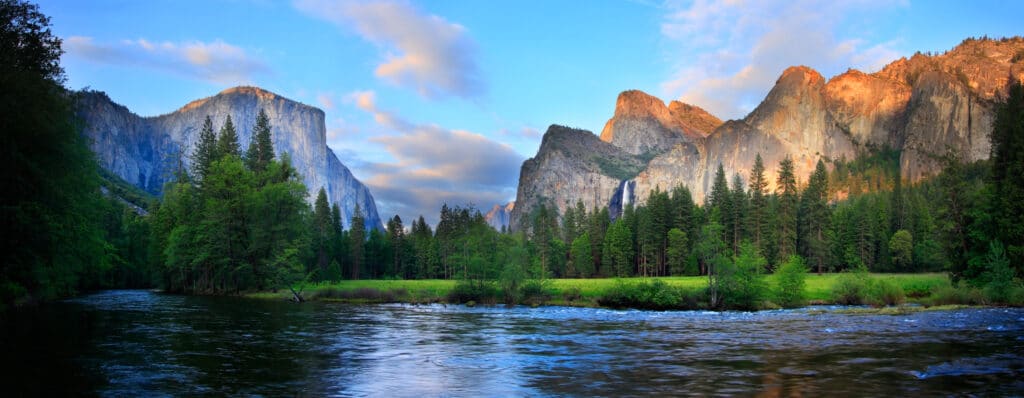
Yosemite National Park charges an entrance fee for all visitors. The standard fee for a private vehicle is $35, which covers everyone in the car and is valid for three consecutive days. Motorcyclists pay $30 per bike (also valid for 3 days), while individuals on foot, bicycle or horseback pay $20 each (those under 16 are free). Frequent visitors can save with a Yosemite Annual Pass for $70, or the America the Beautiful interagency pass for $80 (seniors can get discounted lifetime passes, and active US military, veterans, 4th grade students, and visitors with permanent disabilities are eligible for free passes). The park currently accepts credit/debit cards only at entrance stations (no cash).
Yosemite is open 24 hours a day, 365 days a year, though some access is seasonal. Most park entrances (and roads) operate around the clock, but the remote Hetch Hetchy entrance is only open during daylight hours (approximately sunrise to sunset). Winter conditions close certain high-elevation roads—Tioga Road (Highway 120 through the park) and Glacier Point Road—from roughly November until late spring, depending on snowpack. During the summer peak, visitation is managed with a temporary reservation system: in 2025, for example, a $2 timed-entry reservation is required to drive into Yosemite between 6 am and 2 pm on busy days (such as holiday weekends and mid-June through mid-August). Outside those hours (or with in-park lodging/campground bookings), no reservation is needed to enter. We visited on 22 July 2025, and all figures were valid then.
Exploring the Park: Key Points & Facts
Ever wondered what makes Yosemite so legendary worldwide? The park’s natural grandeur speaks for itself. Yosemite was first protected in 1864 and became a national park in 1890, helping launch the global national park movement. Today it’s recognized as a UNESCO World Heritage Site for its spectacular geology and ecosystems. Towering granite cliffs like El Capitan and Half Dome frame the Yosemite Valley – a U-shaped canyon carved by ancient glaciers – while countless waterfalls (including Yosemite Falls, one of the tallest on the continent at 2,425 ft) thunder down in spring. Beyond the valley, the park spans 1,187 square miles of the Sierra Nevada, ranging from oak woodlands and giant sequoia groves in the lower elevations to alpine meadows and glaciated peaks above 13,000 feet. Almost 95% of Yosemite is designated wilderness, allowing nature to thrive. We’ve road-tripped through many parks, and Yosemite still made us stop and stare in awe at every turn.
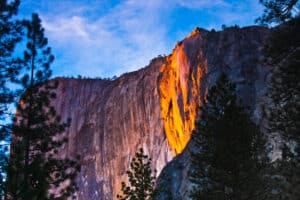
Yosemite National Park
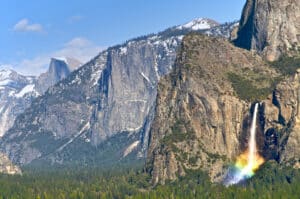
Yosemite National Park
The biodiversity here is just as impressive as the scenery. Giant sequoia trees – among the largest and oldest living things on Earth – flourish in Mariposa Grove and other pockets, reaching over 200 feet tall. Walking among these colossal trunks, it was kinda surreal realizing some were already ancient when the US was founded! The rich habitats support hundreds of wildlife species: we spotted mule deer browsing in the meadows and heard the chatter of Steller’s jays in the pines every morning. Black bears are symbolic residents of Yosemite (around 300–500 black bears roam the park, so storing food properly is a must for campers), and although we only glimpsed a furry shape rustling in the bushes at dusk, it was a thrill. Rarer creatures like the Sierra Nevada bighorn sheep and peregrine falcons have also rebounded here thanks to conservation efforts. Park rangers and scientists work hard to protect this environment – from restoring wetlands and meadows along the Merced River, to using controlled fires to maintain healthy forests (after a century of fire suppression, they’ve learned that regular low-intensity fires are vital for sequoia regeneration and reducing severe wildfire risk). All of these natural wonders and efforts come together to make Yosemite not just a scenic wonderland but an evolving story of preservation and ecological stewardship.
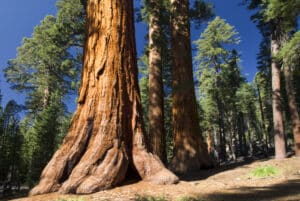
Giant Sequoia tree in the Mariposa Grove, Yosemite National Park, California, USA
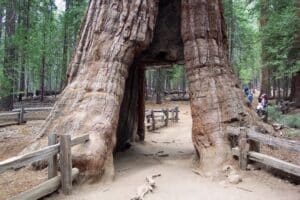
Photo of giant California redwood tree in Mariposa Grove of Yosemite National Park. Tree is one of 3 redwoods at least 3000 years old.
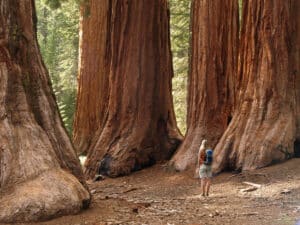
Yosemite National Park – Mariposa Grove Redwoods
For visitors, Yosemite offers more to explore than we could squeeze into one trip. Popular hiking trails crisscross the valleys and high country. We tackled the classic Mist Trail up to Vernal and Nevada Falls – climbing steep stone steps right next to a thundering waterfall (and getting delightfully drenched by its mist!). On another day we hiked the Yosemite Falls Trail to the top of North America’s highest waterfall, panting our way up countless switchbacks for an unbeatable view of the valley floor.
These trails are challenging but absolutely worth it. And there’s plenty of easier walks too, like the loop to Mirror Lake or the shady path to Lower Yosemite Fall, which were perfect for a relaxed afternoon stroll. With over 800 miles of trails, there’s so many options that it was tough deciding where to go – one reason we intend to return. For a different perspective, we even rented bikes one sunny afternoon and cycled around Yosemite Valley’s bike paths, coasting past meadows, rivers, and deer munching obliviously nearby. Whether you’re a casual sightseer or an avid adventurer, plan to spend at least a couple of days here.
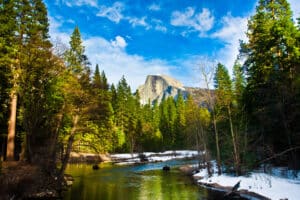
Half Dome Rock , the Landmark of Yosemite National Park,California,United States
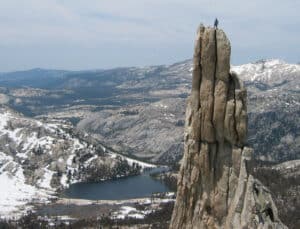
Top of the Worlds. Climber on top of Cathedral Peak in Tuolumne Meadows, Yosemite
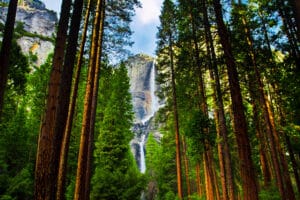
Yosemite Waterfalls behind Sequoias in Yosemite National Park,California
Our average day was packed from sunrise to stargazing; in fact, one evening we lay back in an open meadow to watch the night sky fill with countless stars. (We’ve never seen the Milky Way so clearly until that night.) If you want wildlife encounters, go early – dawn and dusk were when we saw the most animals, plus the soft light on the cliffs is pure magic. And if you want a moment of solitude in this popular park, we learned that hitting the trails at daybreak or exploring outside the main valley (like Tuolumne Meadows or Wawona area) can let you escape the crowds even in July.
Nearby Activities, Eats & Scenic Trails
Yosemite’s splendors aren’t confined to one valley – and our trip didn’t end at the park’s gates. Here are some of the must-see sights inside the park and a taste of what awaits in the nearby towns just outside Yosemite:
-
Tunnel View (inside park): This legendary roadside viewpoint was our first stop, and it honestly looks like a giant postcard come to life. We pulled over at sunrise to see Yosemite Valley spread out below us, framed by El Capitan on the left, Bridalveil Fall tumbling to the right, and Half Dome peeking in the distance. It’s a quick stop but one we couldn’t resist returning to at different times of day just to see the changing light – the view was that breathtaking.
-
Glacier Point (inside park): A winding drive (or strenuous hike) up to Glacier Point gave us one of the most panoramic vistas we’ve ever experienced. Standing 3,000 feet above the valley, we felt as if we were on top of the world. From the railing, we could look almost eye-level at Half Dome across the way and straight down to the tiny ribbon of Merced River below. We were gonna call it an early night, but we spontaneously drove up here for sunset – and it was absolutely worth the winding road in the twilight. The sky turned pink and orange over the Sierra peaks, an unforgettable finale to our day.
-
Mariposa Grove of Giant Sequoias (inside park): Near the park’s South Entrance, this grove is home to over 500 mature giant sequoias. We took the shuttle (when it was running) from the welcome plaza and then wandered among titans like the Grizzly Giant (a massive sequoia about 2,000 years old). Each of these ancient giants were living history towering above their surroundings. The park has done a lot to protect this area – recently removing old asphalt and tram tours – so now it’s just dirt trails, boardwalks, and the sound of wind in enormous treetops. Walking here, we felt tiny and humbled, and our necks actually got sore from looking up so much!
-
Waterfall and Meadow Trails (inside park): In Yosemite Valley, nearly every trail leads to something jaw-dropping. Aside from our bigger hikes, we loved the easy walk to Bridalveil Fall, where a short misty trail took us to the base of a graceful waterfall that soaks you if the wind shifts. We also strolled out to Cook’s Meadow Loop, an open field in the heart of the valley with boardwalks over soggy patches – from there, you can gaze up at both Half Dome and Yosemite Falls while standing among wildflowers. It’s a great spot to picnic or just lay in the grass listening to birds. Another hidden gem we discovered was Taft Point (via a moderate 1-mile hike off Glacier Point Road): from its railed cliff edge, we peered straight down into Yosemite Valley – a dizzying but thrilling vantage point far less crowded than Glacier Point. Honestly, around every corner there’s another trail or vista begging to be explored.
-
Mariposa (outside park): After our adventures, we spent a night in the charming town of Mariposa, about 45 minutes west of the park’s Arch Rock entrance. This historic Gold Rush town was the perfect place to relax and refuel. We grabbed dinner at the 1850 Restaurant & Brewery, a local favorite known for its “twisted” gourmet burgers and house-brewed beers. A juicy bacon-avocado burger and a cold pint of IPA never tasted so good after a long hike! The next morning, we treated ourselves to gigantic cinnamon rolls and coffee at a family-run bakery on Main Street (the smell alone lured us in). Mariposa’s quaint downtown also offered fun window-shopping – we browsed a few art galleries and an old general store selling rustic souvenirs and locally made crafts. It was a pleasant way to wind down, mixing a bit of Gold Country history with our Sierra Nevada adventure.
-
Groveland (outside park): On our way out via the Big Oak Flat entrance (Highway 120), we drove through Groveland – a small frontier-flavored town that once served miners and loggers. We couldn’t resist stopping at the Iron Door Saloon, which proudly claims to be California’s oldest continuously operating saloon (established in 1852!). Stepping inside felt like walking into the Old West, with its antique bar and walls covered in dollar bills and memorabilia. We enjoyed a hearty sandwich lunch here – nothing fancy, but the portions were huge and the vibe was authentic. Chatting with the friendly bartender and locals, we got a sense of the community that lives just outside Yosemite’s busy gates. Groveland had a couple of cute antique shops and an ice cream parlor, but mostly it was the character of the saloon that made the detour worthwhile.
Our journey through Yosemite National Park was filled with natural wonders, a bit of learning, and plenty of memorable moments. We left with dusty boots, full hearts, and a few minor sunburns – and already a list of what we’ll see next time. Yosemite is the kind of place that can’t be experienced in one go; it’s too vast, too varied, and too special. As we drove away under the glow of a last alpine sunset, we were already talking about when we’d be back.
Sorry, there were no items that matched your criteria.

